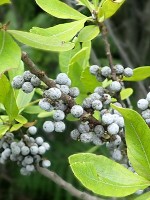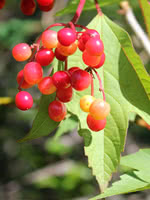Mon-Fri 9am - 5pm Mountain time
Highbush Cranberry vs Northern Bayberry
Myrica pensylvanica
Viburnum opulus var. americanum (trilobum)
NOT AVAILABLE THIS SEASON - MIGHT RETURN
Northern Bayberry makes an excellent hedge or feature shrub. It will retain its leaves in warmer climates but drops them in colder areas. They produce blue-grey berries that have a wax coating on them that can be used to make candles or soaps.
In colder hardiness zones the leaves turn an attractive orange to red colour in the fall, making it a striking addition to your landscape.
Northern Bayberry is native to Nova Scotia and tolerates both drought and wet conditions. It is also a nitrogen fixer that tolerates poor soil conditions.
Highbush Cranberry produces attractive white flowers in late June and bears edible fruit that matures to a bright red colour in the late summer.
This shrub, native to much of Canada, is fast growing, and its fruit can be eaten raw or cooked into a sauce.
Northern Bayberry Quick Facts
Highbush Cranberry Quick Facts
Toxicity: Warning: The wax from bayberry fruit is considered toxic and may be carcinogenic.
In row spacing: 0.6 m (2.0 ft)

